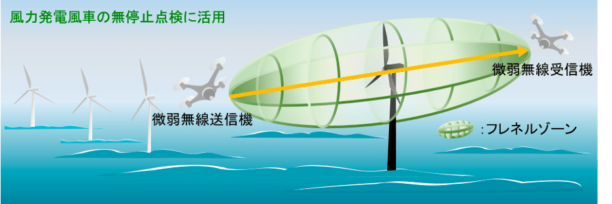
Japanese Company Showcases First Non-Stop Wind Turbine Inspection Technology Using Drones
by DRONELIFE Staff Writer Ian J. McNabb

According to NTT’s press release, Japan, which has invested heavily in wind power and is building large new farms off its long coastline, will have over 3,600 new wind turbines constructed by 2040. Finding improved ways to service the often-remote units is important for easing the transition into greener forms of energy, so the autonomous drones can make inspection of offshore turbines much easier. By using the radio field, the drones accurately gauged the degree of damage on a moving turbine arm without requiring stationary analysis, albeit in a controlled lab setting.
Working on wind turbines can be dangerous, with often stormy conditions and the dizzying heights involved presenting considerable barriers to regular maintenance. NTT hopes that integrating more remote and autonomous systems with wind farms can result in a greener, more efficient future. While this technology is promising, so far, it’s mostly a proof-of-concept, with NTT not announcing a timeline for release, but innovative uses for drones will continue to appear across the global economy, especially when it comes to the rollout of renewable energy sources worldwide. According to NTT, next steps will include a larger-scale outdoor test on multiple functioning units to further develop the process.
Read More:
- Flying Cars Take Off: Skydrive Announces Consumer Pre-Orders
- Drones for Wind Turbine Inspection: ONYX Insight and Nearthlab Partner on Predictive Maintenance
- Drone Inspections for Wind Turbines in as Little as 15 Minutes: Korean Drone Software Company Nearthlab
- Japan’s SkyDrive Will Leverage Suzuki’s Manufacturing to Build eVTOL Aircraft
Miriam McNabb is the Editor-in-Chief of DRONELIFE and CEO of JobForDrones, a professional drone services marketplace, and a fascinated observer of the emerging drone industry and the regulatory environment for drones. Miriam has penned over 3,000 articles focused on the commercial drone space and is an international speaker and recognized figure in the industry. Miriam has a degree from the University of Chicago and over 20 years of experience in high tech sales and marketing for new technologies.
For drone industry consulting or writing, Email Miriam.
TWITTER:@spaldingbarker
Subscribe to DroneLife here.
